The last place we visited on our day trip to Sintra was the National Palace of Sintra, also known as the Town Palace. It may not have the bright colors of Pena Palace or the views of the Moorish Castle, but it is the best preserved medieval royal residence in Portugal.
Note: It can be confusing that there are two national palaces in Sintra. The National Palace of Pena (also just referred to as Pena Palace) is the colorful palace on top of one of the Sintra hills. This post covers the National Palace of Sintra (also known as the Town Palace or Palácio Nacional De Sintra) which is white and located in the Sintra historic center.
Note: This post contains affiliate links. Please see disclosure for information.
COVID-19: Please follow government guidelines. The National Palace of Sintra is open, but there are special rules, so please check here before planning your visit. Alternatively, you may enjoy these virtual tours of castles.
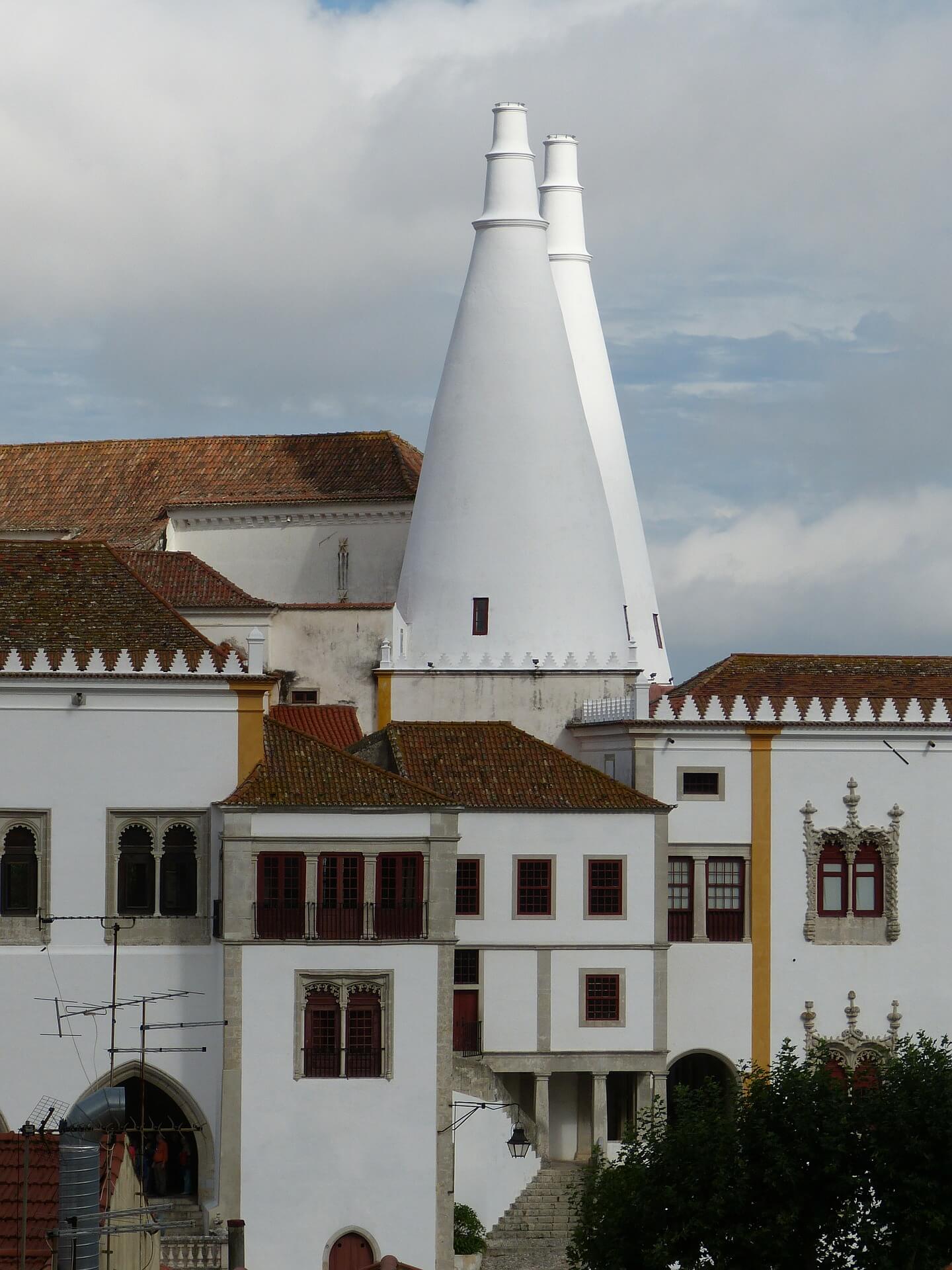
Contents
National Palace of Sintra History
Monarchs made the National Palace of Sintra their home from the 15th to the 19th century, mainly in the summer months to escape Lisbon’s heat, making it the most lived-in palace in Portugal. The history of the National Palace of Sintra goes all the way back to at least the 10th century. A residential palace was built on this site by the Moors who at the time ruled the region.
In 1147, Dom Afonso Henriques captured Sintra from the Moors and occupied the palace. The royal family continued to use the palace until 1880. In 1910, after the proclamation of the republic, the palace became a national monument.
Town Palace Architecture
Most of the National Palace dates back to 13th to 16th centuries. Kings Dinis, João I and Manuel I sponsored construction campaigns that have given the palace its present-day appearance. You will see a mixture of Gothic, Manueline and Moorish architectural styles in the palace.
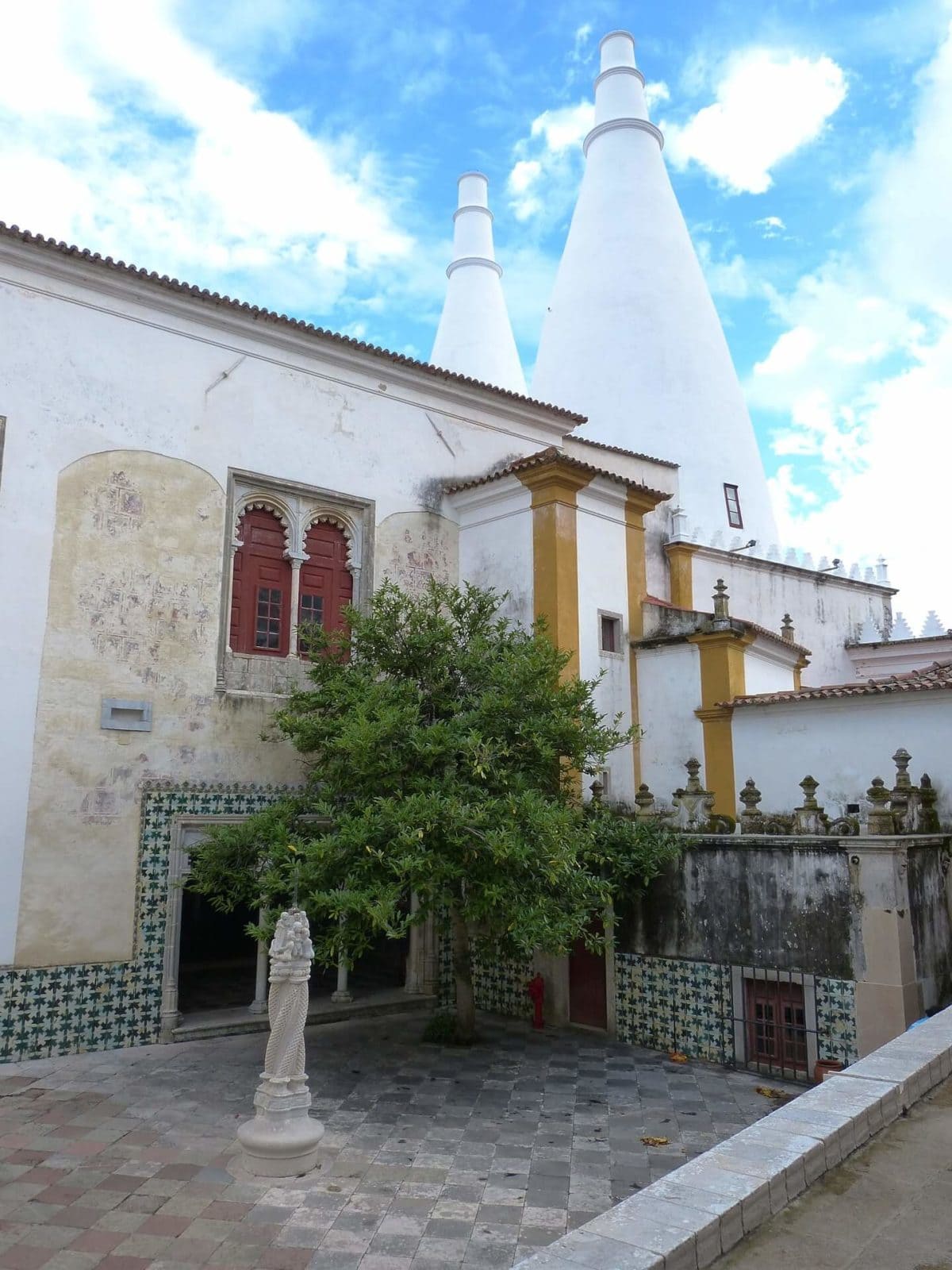
You can recognize the Sintra National Palace by the two large eye-catching white cones on top of the roof. We could easily spot the National Palace of Sintra from the top of the hill, you can’t miss the cones! These are actually huge chimneys that were built in the 14th to keep the kitchen smoke free. The chimneys are visible for miles and have become the symbol of Sintra.
While the palace’s exterior is known for the two monumental chimneys, the interior design is impressive as well. The walls inside the National Palace are lined with Europe’s largest set of Mudejar tiles still in place today. (If you’re curious, read more about Portuguese tiles and how to make your own.) You will also see intricate woodwork and priceless antiques.
National Palace of Sintra Highlights
In my opinion, the National Palace of Sintra interior is what makes it special. It looks like a royal palace! You will see some elaborate ceilings, impressive tile work, and beautiful antiques. I wanted to point out my favorite rooms, some even had a theme!
The National Palace of Sintra interior is impressive and definitely worth a visit!
Swan Hall
This room gets its name from the swans on the ceiling. The Swan Room was the original Grand Hall of the Palace during the time of Jaoa I and was built the beginning of the 15th century. It had to be restored after the 1755 earthquake. Important functions would have been held in this room.
The Magpie Room
Important dignitaries and ambassadors were received in the palace in the Magpie room. The room gets its name for the 136 magpies, each one holding a rose and a scroll with the words ‘Por bem,’ painted on the ceiling.
Exactly why there are magpies painted on the ceiling is debated.
According to one story, the room was decorated with magpies since the king thought the women at the court chattered like magpies. Another story claims King Joao made gave one of the ladies-in-waiting a rose behind the back of his wife, Queen Philippa. A magpie snatched the rose and the king, who was caught red-handed, explained himself with the words ‘Por bem’ (which means “for the good”) and commissioned a painting of a magpie for each of the 136 ladies-in-waiting.

King Sebastian’s Bedchamber
This room used to be called the Gold Chamber at the beginning of the 15th century, but it no longer has the gold decorations. It was used as the bedchamber of King Sebastian at the end of the 16th century. The tile walls with the raised vines are quite unique.
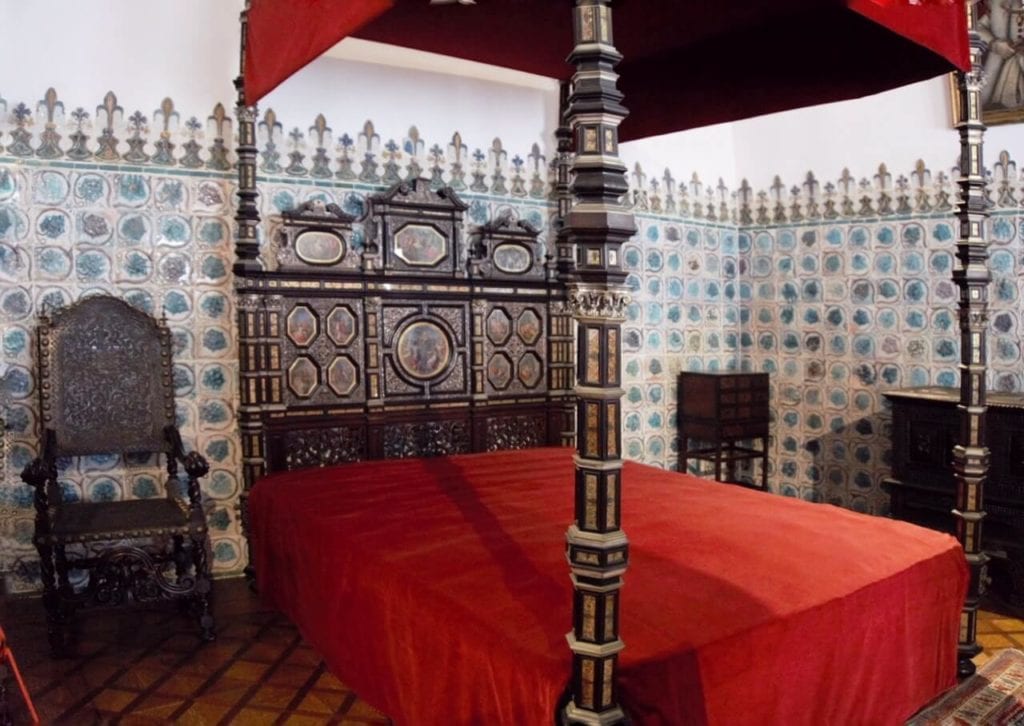
Chinese Room
The Chinese Room was part of the old palace of King Dinis and used as the bedchamber for Joao I until he finished the construction work in the beginning of the 15th century. The 18th-century ivory Chinese Pagoda now on display gives the room its name.
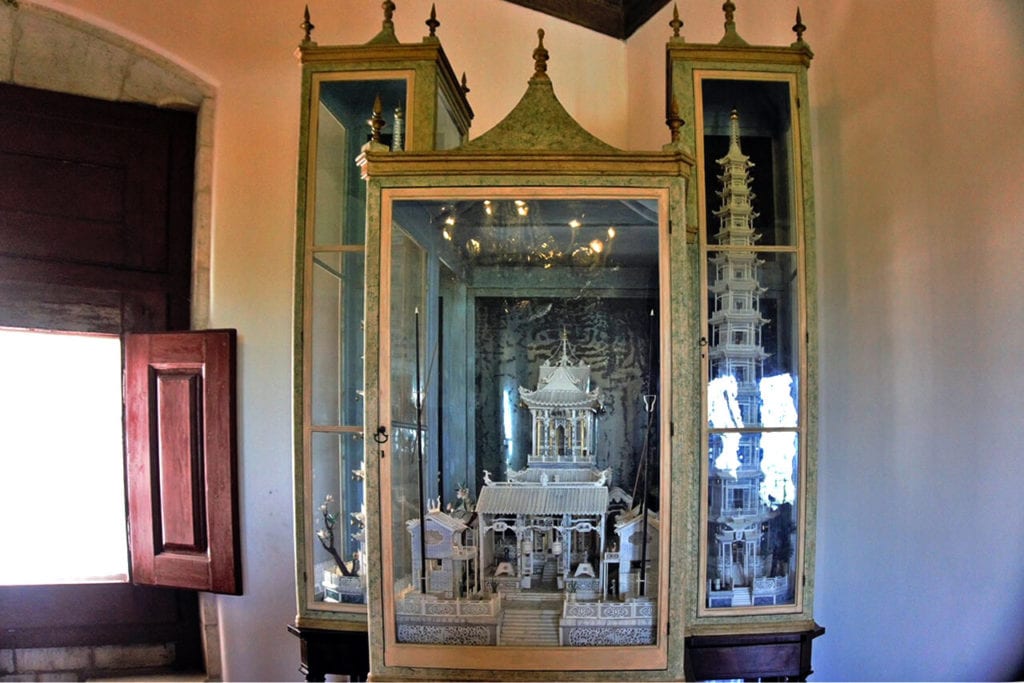
Blazons Hall
This room is situated where the old Casa da Meca was built during the time of Manuel I (1495-1521). I was impressed with the woodwork on the hexagonal ceiling and the tile work on the walls that depict hunting scenes. The walls were actually added in the 18th century.

Palatine Chapel
King Dinis was the first king to try to improve the palace in the 13th-14th century and the main surviving room from this time is the Chapel. It is a small Gothic chapel with a Moorish-styled ceiling. This ceiling and the tiled floors and the wooden ceiling are some of the oldest examples of Moorish craftsmanship in Portugal.
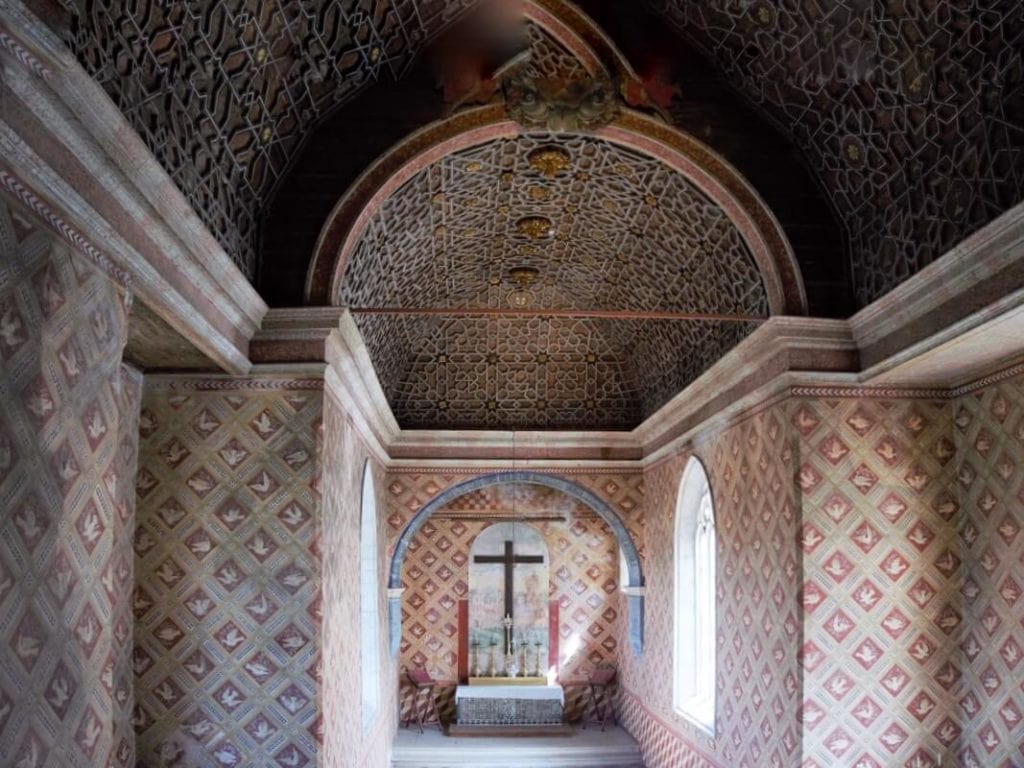
Grotto of the Baths
No summer house would be complete without a little outdoor space or “casa de fresco”. I just loved the tile work in this area. The walls have panels that depict fountains and gardens. The ceiling features art showing the creation of the world along with other mythological themes. You can also see tiny openings in the walls that were for the water jets that crisscrossed the room.

Kitchen
I didn’t realize until I went into the kitchen that the cones on top of the Palace were chimneys! I was interested to see them from underneath. This kitchen was built by King João I and used to prepare food for the royal banquets.
Can you imagine the banquets held at the National Palace that would have required such massive chimneys? That must have been some spread! You can also see the original roasting spits and various other cookware on display in the kitchen.
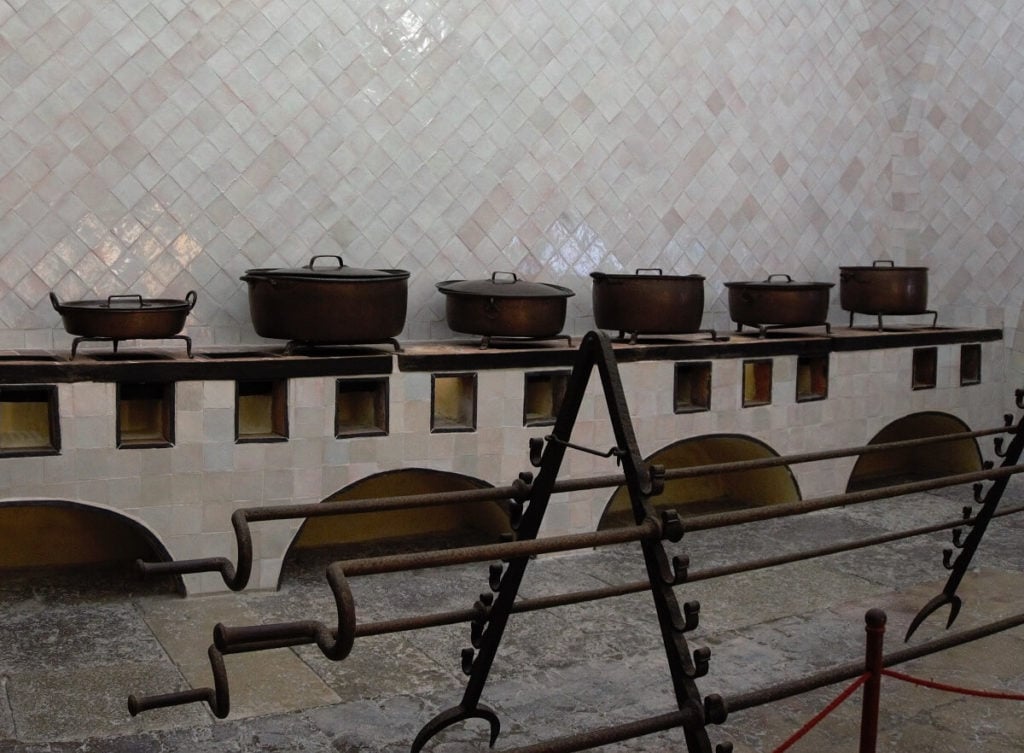
Logistics for Visiting the National Palace of Sintra
How to Get to the Sintra National Palace
The National Palace of Sintra is located in the historic center of Sintra. On the hop-on hop-off bus it is the closest stop to the train station. You can walk from the train station if you prefer. It’s about a 15 minute walk but it will be uphill. It’s not as steep as the walk up to Pena Palace or the Moorish Castle but it is uphill none the less.
National Palace of Sintra Hours
The Sintra National Palace opening hours do vary by season, but you can expect it to be similar to 9:30 am – 6 pm. Please check the website for the most up to date information and last entry times.
Sintra National Palace Admission
Tickets for the National Palace of Sintra can be purchased online in advance. If you purchase a combined ticket to more than one Sintra site you can save money.
When to Visit the Town Palace
Since the National Palace is the closest of the Sintra tourist attractions to the train station, many people start sightseeing there. If you have some flexibility in how you plan your time in Sintra, you might like to visit this palace later in the day to avoid the crowds. We came in the afternoon and there were not many people around at all.
I would recommend allocating 1 ½ to 2 hours for your visit. Once you are done you can visit one of the restaurants across the street to try Sintra’s famous orange dessert.

Is Sintra National Palace a good place to visit with kids?
Some kids may enjoy the National Palace of Sintra, but in general, I think they will prefer the Castle of the Moors or Pena Palace. Sintra National Palace is more about the history tand decor inside the castle and some children may find it boring.
Is the National Palace of Sintra Worth Visiting?
Even if you’re not impressed with all the history of the Sintra National Palace, you should visit to see the elaborate interior. Each wall, ceiling, and floor was beautifully decorated with such detail.
It may not be a well-known as some of the other castles in Sintra because it may not be as instagram-worthy from the outside given its location in middle of town. Inside though, the rooms you see are more elaborate than the other sites we toured.
Have you visited the National Palace of Sintra?
–Anisa
Pin for Later
Expert Tips for Visiting the Town Palace
- Buy the combined ticket online to save money on the Sintra National Palace entrance fee.
- Go in the afternoon so you miss the crowds
Disclosure: This post contains affiliate links. This means we will receive a small commission for some purchases made using links in our blog with no additional cost to you. Please be assured we would not promote any product unless we believe that our readers will also benefit. The commission does not influence the editorial content of this site.
Last Updated on March 7, 2023



